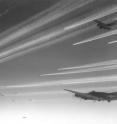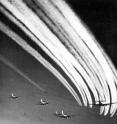World War II bombing raids offer new insight into the effects of aviation on climate
Climate researchers have turned to the Allied bombing raids of the Second World War for a unique opportunity to study the effect thousands of aircraft had on the English climate at a time when civilian aviation remained rare. The study, published in the International Journal of Climatology, reveals how civilian and military records can help assess the impact of modern aviation on the climate today. The research, led by Prof Rob MacKenzie, now at the University of Birmingham, and Prof Roger Timmis of the Environment Agency, used historical data to investigate the levels of Aircraft Induced Cloudiness (AIC) caused by the contrails of Allied bombers flying from England to targets in Europe. The team focused their research on 1943 to 1945 after the United States Army Air force (USAAF) joined the air campaign.
"Witnesses to the huge bombing formations recall that the sky was turned white by aircraft contrails," said MacKenzie. "It was apparent to us that the Allied bombing of WW2 represented an inadvertent environmental experiment on the ability of aircraft contrails to affect the energy coming into and out of the Earth at that location."
Aircraft can affect cloudiness by creating contrails, formed when the hot, aerosol-laden, air from aircraft engines mixes with the cold air of the upper troposphere. While some contrails disappear swiftly, others form widespread cirrus clouds which intercept both the energy coming into the planet as sunshine and that leaving the planet as infrared heat.
When the USAAF joined the Allied air campaign in 1943 it led to a huge increase in the number of planes based in East Anglia, the Midlands and the West Country. Civil aviation was rare in the 1940s, so USAAF combat missions provide a strong contrast between areas with busy skies and areas with little or no flight activity.
Today air travel is growing at an annual rate of 3-5 % for passenger aircraft and 7 % for cargo flights, but quantifiable data on the impact of AIC remains rare. In September 2001 United States airspace was closed to commercial aircraft following terrorist attacks, presenting scientists with a unique moment to study the effect of aircraft contrails in normally busy sky. Results from the 9/11 studies are controversial, but now MacKenzie and his colleagues have found an opportunity to study the opposite impact of contrails on the usually empty skies of the 1940s and have found that it is indeed possible to see the effects of AIC in surface weather observations, but that the signal is weak.
The study involved painstaking retrieval of historical records, both from the Meteorological office and from the military. The importance of weather conditions to the success of bombing missions meant that the Second World War prompted some of the most intensive weather observations ever undertaken but these are not all archived electronically.
To distinguish the effect of aviation more clearly, the team focused on larger raids from the many flown between 1943 and 1945. They selected raids that involved over 1000 aircraft and that were followed by raid-free days with similar weather which might be used for comparison. The resulting top 20 raids revealed 11th May 1944 as the best case study.
The team found that on the morning of the 11th 1444 aircraft took off from airfields across south east England into a clear sky with few clouds. However, the contrails from these aircraft significantly suppressed the morning temperature increase across those areas which were heavily over flown.
"This is tantalising evidence that Second World War bombing raids can be used to help us understand processes affecting contemporary climate," concluded MacKenzie. "By looking back at a time when aviation took place almost entirely in concentrated batches for military purposes, it is easier to separate the aircraft-induced factors from all the other things that affect climate."

